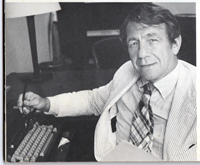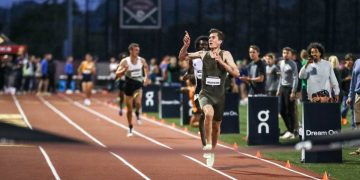The following piece was sent to us by former New York Times columnist Frank Litsky, a long time colleague and friend of James Dunaway, who died on Sunday, March 15, 2015, after a long and colorful career in athletics journalism.
RelatedPosts
DUNAWAY
By Frank Litsky
James Dunaway’s track and field credentials are overwhelming. He has covered 13 consecutive Olympic Games (1956 to 2008), all but one world outdoor championships from 1983 to 2007 (he missed one because he was buying a home in Texas), at least 53 NCAA outdoor championships, more than 100 AAU-TAC-USATF national championships indoors and outdoors, and more Penn Relays and Drake Relays than he can count. He never ran or jumped or threw or officiated in those meets, and never bought a ticket, but he always had the best seat in the house.
He got there with a press credential and an old Royal portable typewriter (and later a laptop). He was a prolific reporter who covered track and other sports, almost always on a freelance basis, for The New York Times, United Press International, ABC-TV, Track & Field News and many more outlets.
He was Eastern editor of Track & Field News from 1963 to 2004 and became editor of American Track and Field in 2004. He has written more than 200 magazine articles on many subjects, not just sports. His writing has appeared in The New York Times, Sports Illustrated, Reader’s Digest, Esquire,MediaWeek, Advertising Age, BRANDWEEK, Runner’s World, The Runner,American Track and Field, Track & Field News and many other publications.
One of his books, “The Sports Illustrated Book of Track and Field: Running Events” (Lippincott, 1968) sold more than 100,000 copies and stayed in print for 20 years. Several coaches called it the best book of its type ever, and it still sells strongly on the Web.
He also wrote “The Four-Minute Mile, 1954-1967,” a self-published, $1-a-copy book with incredible detail after detail of the first 14 years of the four-minute mile. It served as a track statistician’s dream. A review in Sports Illustrated carried this headline: “A Frustrated Five-Minute Miler Gathers the Facts About Sub-Four-Minute Miles.” Actually, the headline was kind. He was a diligent but ungainly runner, and his fastest mile was 5:48.
His peers twice elected him president of the Track and Field Writers of America (TAFWA). He served that organization, the most important in American track, from 1999 to 2002 and again from 2005 to 2007. He was the long-time secretary of the New York Track Writers Association, an organization that helped keep the sport alive in the East at a time when many major indoor and outdoor meets were closing their doors.
TAFWA honored him in 1996 with its prestigious Jesse Abramson Award for outstanding writing. His exclusive stories in 1980 on how the Soviets won five track and field gold medals in the Moscow Olympics by cheating were a journalistic coup.
If all these jobs seem like overkill, they are. Dunaway keeps working and keeps writing, and the track world is the better for it.
In 2010 he was elected to the National Track and Field Hall of Fame, only the second non-magazine journalist so honored. (The first was the same Jesse Abra
mson, of the New York Herald Tribune).
Dunaway was stunned by his Hall of Fame selection.
“I called myself an amateur,” he said. “My day job was something else. You’ve got to understand that this was my hobby, so when track people said I should be in the Hall of Fame, I said, ‘Please don’t nominate me.'”
He was nominated and elected, a fitting tribute to a man who should logically have been doing something else. In 1949, he earned a B.S. degree in chemistry at Penn State. He became an advertising copywriter and serviced such corporate giants as General Electric, DuPont, Kellogg cereals, Proctor and Gamble, Palmolive soap and Nabisco. Later, he spent 19 years with the Newspaper Advertising Bureau, the last 10 as its vice president/information, and served as a spokesman for the newspaper industry.
As a young man in the 1950s, his first residence in New York was a rent-controlled apartment on East 93rd Street for $32 a month. In the early ’60s he lived just off Fifth Avenue in Midtown Manhattan. “5 East 51st Street,” he said, “directly across from the transept of St. Patrick’s Cathedral.” A devoted jazz fan, Dunaway spent many a night in those years in the beloved clubs of 52nd Street, frequenting such legendary jazz haunts as the Three Deuces, The Famous Door and the Downbeat.
James O’Dwyer Dunaway was born Aug. 17, 1927, in Houston. His love affair with track and field started as a student in college, where he was friendly with such celebrated runners as Horace Ashenfelter, later an Olympic steeplechase champion; Curt Stone, later a Pan American Games champion, and Jim Gehrdes, a hurdler and later the Naval Academy and Penn State coach. After college, he worked a year and a half, saved $1,000, quit his job, went to Europe, had a good time and returned six months later with $5.50 in his pocket.
He got another job, but in 1956 he took a year’s leave of absence to see the Melbourne Olympics. He had little money, but through his father, who worked for Texaco, he got free rides on slow tankers. Journalism credentials for the Olympics were easy to get then, but he had hardly any journalistic background, although writing advertising copy had given him a head start.
He did have great journalism bravado. To get money, he invented Hometown Features, a news agency that would service American newspapers with Olympic stories on their hometown heroes, and solicited 34 newspapers. As he recalled it:
“There was one problem: I had never written a news story in my life. On the other hand, those sports editors didn’t know that. I didn’t have any doubts about my ability to do the job, but I didn’t want to lie about my qualifications. So I got a letterhead printed up that looked like I was a freelance journalist, and I wrote a letter which made it sound like I had been writing about sports for years.”
Five of those newspapers hired him to be their man in Melbourne and write about the local athlete who made good. An Oklahoma City newspaper was so impressed with his presentation that it agreed to use him only if he, and not one of his employees, wrote the stories.
He assured that paper that he alone would do the job. That was easy because he had no employees. He was a one-man show, and he did so well that he kept writing at future Olympics for newspapers and wire services in the United States, Italy and Australia; Esquire and other magazines; television, the Web and the IAAF.
In later Olympics and elsewhere, deep into his 80’s, he wrote for just about everyone, always with authority.
He would drive from his home in Tenafly, N.J., and later Austin, Texas, to write about meets in Eugene or Philadelphia or Des Moines or almost anywhere else. He would cover half the country with one overnight stop. Although he paid his own travel expenses, room and board, his greatest motivation was not to make money but to break even. In the process, he brought his track love and wisdom to newspapers in New York, Chicago, Eugene, Des Moines, Houston, Fort Worth, Austin, Baltimore and points between.
In addition, he has served as a sports historian and consultant to ABC Sports, Sports Illustrated, Runner’s World, The Runner and The New York Times.
He has been doing it mainly for the love of a sport to which he gave so much and gave him so much. The trek was not easy.
“Track and field is a very tough sport to cover,” he said. “It’s like 14 different sports, and you have to know about a lot of things. But it still has a lot of vitality. I love it. I just spent too much money on track most of the time, but I did some things that were good.”
Author

Larry Eder has had a 52-year involvement in the sport of athletics. Larry has experienced the sport as an athlete, coach, magazine publisher, and now, journalist and blogger. His first article, on Don Bowden, America's first sub-4 minute miler, was published in RW in 1983. Larry has published several magazines on athletics, from American Athletics to the U.S. version of Spikes magazine. He currently manages the content and marketing development of the RunningNetwork, The Shoe Addicts, and RunBlogRun. Of RunBlogRun, his daily pilgrimage with the sport, Larry says: "I have to admit, I love traveling to far away meets, writing about the sport I love, and the athletes I respect, for my readers at runblogrun.com, the most of anything I have ever done, except, maybe running itself." Also does some updates for BBC Sports at key events, which he truly enjoys. Theme song: Greg Allman, " I'm no Angel."
View all posts





















